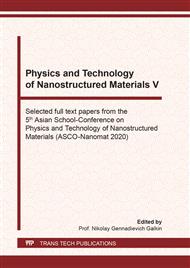[1]
S. Lazarouk, S. Katsouba, A. Leshok, A. Demianovich, V. Stanovski, S. Voitech, V. Vysotski, V. Ponomar, Porous alumina as low-ε insulator for multilevel metallization, Microelectron. Eng. 50 (2000) 321-327.
DOI: 10.1016/s0167-9317(99)00298-1
Google Scholar
[2]
S. Katsouba, P. Jaguiro, S. Lazarouk, A. Smirnov, Stable elec-troluminescence of nanostructured silicon embedded into anodic alumina, Phisica E. 41 (2009) 931-934.
DOI: 10.1016/j.physe.2008.08.051
Google Scholar
[3]
G.D. Sulka, K. Hnida, Distributed Bragg reflector based on porous anodic alumina fabricated by pulse anodization, Nanotechnology. 23 (2012) 075303.
DOI: 10.1088/0957-4484/23/7/075303
Google Scholar
[4]
W. Lee, S. J. Park, Porous Anodic Aluminum Oxide: Anodization and Templated Synthesis of Functional Nanostructures, Chemical reviews. 114 (2014) 7487-7556.
DOI: 10.1021/cr500002z
Google Scholar
[5]
M.S. Ilango, A. Mutalikdesai, S.K. Ramasesha, Anodization of Aluminium using a fast two-step process, J. Chem. Sci. 128 (2016) 153-158.
DOI: 10.1007/s12039-015-1006-8
Google Scholar
[6]
A.E. Gridnev, V.V. Chernyshev, Electroluminescence Spectra of Anodic Alumina in Various Electrolytes, Vestnik VGU. 2 (2005) 8-10.
Google Scholar
[7]
S. Stojadinović, R. Vasilić, B. Kasalica, I. Belča, L. Zeković, Luminescence During the Electrochemical Oxidation of Aluminum, in: S.S. Djokić, (Eds.), Electrodeposition and Surface Finishing, Springer, New York, 2014, pp.241-302.
DOI: 10.1007/978-1-4939-0289-7_5
Google Scholar
[8]
L.A. Dubrovsky, V.G. Melnik, L.L. Odynets, Anodic oxidation of silicon in pure water, Journal of Physical Chemistry. 36 (1962) 2199-2204.
Google Scholar
[9]
D.S. Ovechenko, A.P. Boychenko, Glow of Metals during Anodization in Distilled Water, Technical Physics Letters. 45 (2019) 503-506.
DOI: 10.1134/s1063785019050250
Google Scholar
[10]
D.S. Ovechenko, A.P. Boychenko, Thermal influence on the electroluminescence kinetics of aluminum and tantalum in their anodization in distilled water, Ecological bulletin of research centers of the Black sea economic cooperation. 16 (2019) 59-67.
DOI: 10.31429/vestnik-16-2-59-67
Google Scholar
[11]
M.I. Eidelberg, Cathode burst of galvanoluminescence of anodic oxide film on aluminum in diethyl phthalate, Optics and spectroscopy. 16 (1964) 97-101.
Google Scholar
[12]
D.S. Ovechenko, A.P. Boychenko, Electroluminescence anode Aluminum oxide in ketones, Optics and spectroscopy. 128 (2020) 256-262.
DOI: 10.1134/s0030400x20020186
Google Scholar
[13]
S.K. Lazaruk, P.S. Katsuba, A.A. Leshok, V.B. Vysotsky, Effect of local electric field strength on the formation of the ordered structure of a porous anodic aluminum oxide, J. Technical Physics. 85 (2015) 86-90.
DOI: 10.1134/s1063784215090108
Google Scholar
[14]
V.A. Sokol, Growth features of porous aluminum oxide, Reports BSUIR. 1 (2003) 75-82.
Google Scholar
[15]
D.P. Barkey, U.S. Patent 9,689,064 B2. (2017).
Google Scholar
[16]
Yoriya Sorachon, Materials Challenges and Testing for Manufacturing, Mobility, Biomedical Application and Climate, Springer, USA, (2014).
Google Scholar


